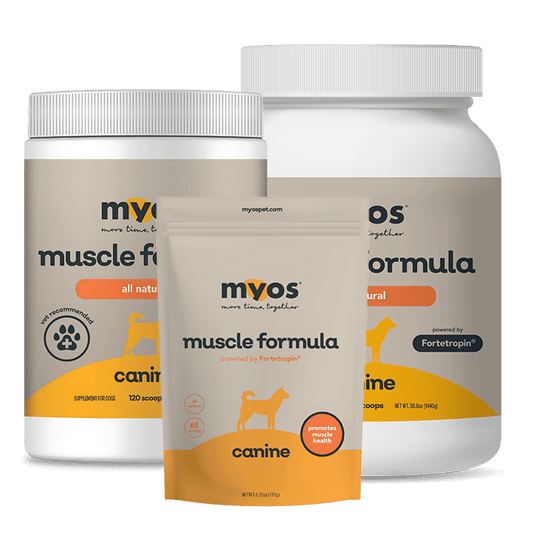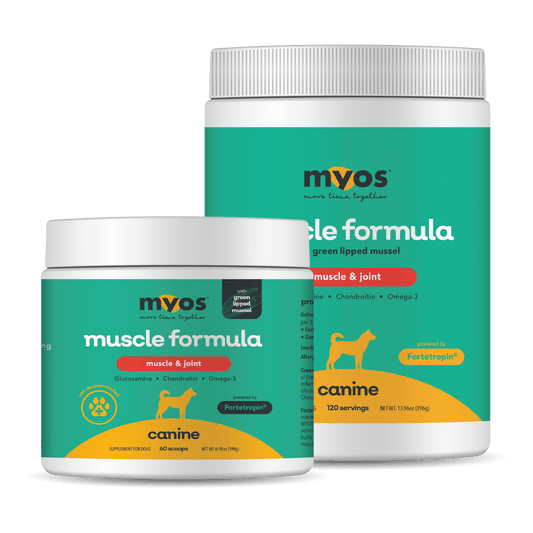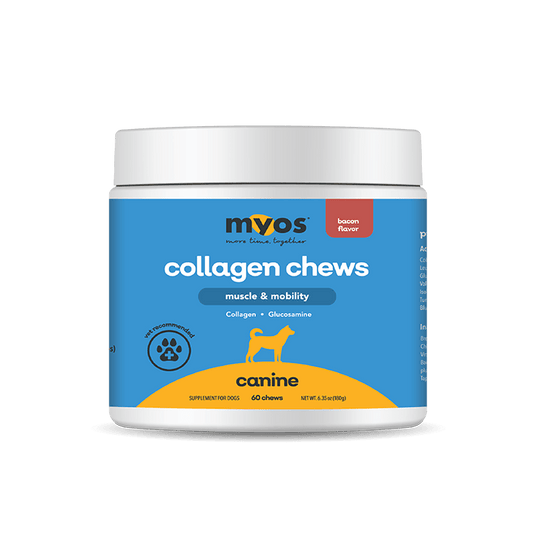By Neerav D. Padliya, Ph.D.
Background: Small Animal Sarcopenia
Not only is sarcopenia, the gradual loss of muscle mass and function, a major health problem for humans, it is also a major health problem faced by geriatric dogs and cats and has been reviewed by Freeman [1,2]. Human clinical trials [3,4] and veterinary clinical trials in dogs [5] have highlighted that sarcopenia is associated with elevated mortality risk. Muscular strength in humans is commonly assessed by grip strength [6] or one repetition maximal measures for leg and bench presses [7]. Although these measurements cannot be used in the field of Veterinary Medicine, the 6 Minute Walk Test (6MWT) which is used extensively in Human Medicine to assess respiratory function [8] has also been utilized in Veterinary Medicine [9].
The 6 Minute Walk Test in Dogs
Pulmonary Disease and Chronic Heart Failure:
In a study published by Swimmer and Rozanski [9] at Tufts University School of Veterinary Medicine, the distance walked over the course of 6 minutes was compared between 69 healthy dogs and 6 dogs with pulmonary disease. Dogs with pulmonary disease were able to walk on average only 384.8 + 4.0 meters in comparison with healthy dogs that could walk 522.7 + 52.4 meters in comparison. This difference represented a reduction of ~26% in distance walked over 6 minutes between healthy and affected dogs.
Table 1: Utilization of 6 Minute Walk Test in a Veterinary Clinical Study Involving Healthy Dogs and Dogs With Pulmonary Disease. Reproduced from [9].

A similar although much smaller study involving 16 male hound-crossbred dogs with chronic heart failure (CHF) was published in 2004 [10] by researchers at Ohio State University. The distance that dogs with CHF could walk over 6 minutes was much lower in comparison to the distance walked by healthy dogs.
Obesity:
Manens and colleagues at James Cook University, Australia used the 6MWT to assess the detrimental impact of obesity on dogs [11]. They also studied the impact that body weight loss has on distance that can be walked in the 6MWT. For obese, overweight and lean dogs, the 6MWT distances were 509 ± 35 m, 575 ± 36 m, 589 ± 36 m ( p ≤ 0.05).
Figure 1: Heart Rate Measured During 6MWT in Manens et al. [9] For Obese, Overweight and Lean Dogs [11]. Image reproduced from [11].

Figure 2: Pulse Oximetry Measured During 6MWT in Manens et al. [9] For Obese, Overweight and Lean Dogs [11]. Image reproduced from [11].

It is clear from Figure 1 that obese dogs had a significantly increased heart rate when compared with lean and overweight dogs when completing a 6MWT. There was also a significant drop in SpO2(%) in the obese dogs after walking 6 minutes which was noted in Figure 2. Building muscle mass would clearly help increase resting ATP consumption, reducing excess adiposity.
Muscular Dystrophy:
Ascota and colleagues at Texas A&M University studied the impact of Golden Retriever Muscular Dystrophy (GRMD) on 6MWT performance. Below they compare 6MWT performance between normal and GRMD dogs. It is clear that there are major differences in 6MWT performance at 6 and 12 months between normal dogs and dogs with GRMD.
Figure 3: Box Plots Showing 6MWT Results for Normal Golden Retrievers and Golden Retrievers with Muscular Dystrophy (GRMD) at 3, 6 and 12 Months of Age. Image reproduced from [12].

Fortetropin®: Advanced Nutrition to Address Muscle Loss in Dogs
Fortetropin® is an advanced nutrition product made from fertilized chicken egg yolk using a patented, low temperature manufacturing process [13,14] that helps to better retain the natural bioactivity of the proteins, peptides and lipids that are found to be present within fertilized, chicken egg yolk. In human clinical studies, Fortetropin® has been shown to increase the rate of muscle protein synthesis [15] and lead to gains in muscle mass and strength [16].
In a randomized, double blind, placebo-controlled study involving 100 dogs recovering from TPLO surgery conducted at Kansas State University, daily consumption of Fortetropin® led to reduced muscle atrophy and improved recovery in dogs [17]. A follow up clinical study is currently underway to examine the impact of Fortetropin® on quality of life and mobility on geriatric dogs at Kansas State University. The 6MWT is a simple test that the Veterinarian can perform to assess the impact of interventions designed to improve the muscle health of the aging dog.
Learn more about how Fortetropin® can make a difference for aging dogs at www.myospet.com.
References
- Freeman, L. M. "Cachexia and sarcopenia: emerging syndromes of importance in dogs and cats." Journal of veterinary internal medicine1 (2012): 3-17.
- Freeman, Lisa M. "Cachexia and Sarcopenia in Companion Animals: An Under‐Utilized Natural Animal Model of Human Disease." JCSM Rapid Communications2 (2018): 1-17.
- Ruiz, Jonatan R., et al. "Association between muscular strength and mortality in men: prospective cohort study." Bmj337 (2008): a439.
- Caan, Bette J., et al. "Association of muscle and adiposity measured by computed tomography with survival in patients with nonmetastatic breast cancer." JAMA oncology6 (2018): 798-804.
- Hua, Julie, et al. "Assessment of frailty in aged dogs." American journal of veterinary research12 (2016): 1357-1365.
- Duchowny, Kate A., P. J. Clarke, and Mark D. Peterson. "Muscle weakness and physical disability in older Americans: longitudinal findings from the US Health and Retirement Study." The journal of nutrition, health & aging4 (2018): 501-507.
- Ruiz, Jonatan R., et al. "Association between muscular strength and mortality in men: prospective cohort study." Bmj337 (2008): a439.
- Enright, Paul L. "The six-minute walk test." Respiratory care8 (2003): 783-785.
- Swimmer, Rebecca A., and Elizabeth A. Rozanski. "Evaluation of the 6‐minute walk test in pet dogs." Journal of veterinary internal medicine2 (2011): 405-406.
- Boddy, Kirstin N., et al. "Evaluation of the six-minute walk test in dogs." American journal of veterinary research3 (2004): 311-313.
- Manens, J., et al. "Effect of body weight loss on cardiopulmonary function assessed by 6‐minute walk test and arterial blood gas analysis in obese dogs." Journal of veterinary internal medicine2 (2014): 371-378.
- Acosta, Austin R., et al. "Use of the six-minute walk test to characterize golden retriever muscular dystrophy." Neuromuscular Disorders12 (2016): 865-872.
- Buxmann, Waldermar, et al. “Process for producing a composition for increasing muscle mass.” S. Patent # 10,165,785, Issue Date: January 1, 2019.
- Buxmann, Waldermar, et al. “Process for producing a composition containing active follistatin.” S. Patent #8,815,320, Issue Date: August 26, 2014.
- Evans, William J., et al. “Effects of Fortetropin® on the rate of muscle protein synthesis in older men and women: a randomized, double blinded, placebo-controlled study.” Gerontol Med Sci, submitted.
- Sharp, Matthew H., et al. "The effects of fortetropin supplementation on body composition, strength, and power in humans and mechanism of action in a rodent model." Journal of the American College of Nutrition8 (2016): 679-691.
- White, Dana A., et al. "Fortetropin inhibits disuse muscle atrophy in dogs after tibial plateau leveling osteotomy." PloS one4 (2020): e0231306.





